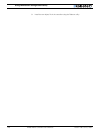
Mechanical Specifications
152 AX500 Motor Controller User’s Manual Version 1.9b. June 1, 2007
Note that the back of the PCB has large copper areas exposed just under the power MOS
area. It is critical that the interposer either is insulated (example: anodized aluminum) or a
layer of thermal conducting - but electrically insulating - pad is used.
Failure to do so will cause a short among the drains of the power MOS and the board will
fail. Ordinary thermal grease will not act as an insulator.
The interposer has to be planar so to ensure good thermal contact wit all power MOS; in
alternative use thermal conducting pad that will fill all the voids between the board and the
interposer.
Precautions to observe
Use plastic washers for the screws securing the board to the interposer similar to the ones
originally installed. They will prevent the head of the screw from touching the heat sinks of
the power MOS an from damaging the PCB and making contact with the copper layers
underneath.
Should the board be expected to experience heavy vibrations, then use plastic shoulder
washer, which will keep the stem of the screws centered.
Make sure the screws holding the corners do not bend the board, which remains flat. The
screws that should hold securely the PCB are the ones in the power MOS area where the
best contact is needed for efficient heat transfer.
The four screws at the corners do not need to be tightened excessively and they also
require a plastic washer to avoid damage to the PCB. It is a good practice to use nylon
screws (8-32 minimum size) for electrical isolation and to allow some elasticity in case of
vibrations.
At the end of the assembly process check that there is no electrical continuity between
any of the power contacts and the interposer/chassis with an ohm meter prior to applying
power.
Board
Metal Chassis
Metal Interposer
Thermal Pad
Spacer
FIGURE 89. Mount the controller without heatsink against a chassis


















